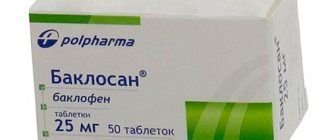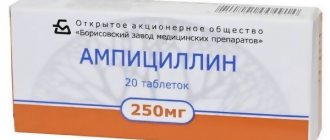Singulair is an anti-inflammatory drug that affects the respiratory system.
Prevents the production of pathological mediators and bronchospasm. Prescribed for bronchial asthma and other severe allergic conditions. Used in emergency cases, it belongs to the prescription group of drugs.
The use of Singulair in children under 2 years of age is contraindicated. In this case, the smallest patients can only be given chewable tablets of 4 mg of the active ingredient. Chewable tablets of 5 mg are prescribed from the age of six, and coated tablets are allowed only from the age of 15.
pharmachologic effect
The drug Singulair is a leukotriene receptor antagonist. The main component of the drug inhibits leukotriene-type cysteinyl receptors in the respiratory tract. At the same time, its ability to inhibit bronchospasm is also manifested.
A dose of 5 mg is considered sufficient to relieve this symptom. If Montelucas is taken in a dose of 10 mg or more, the effect of the drug does not increase.
The active substance provokes bronchodilation for 2 hours from the moment of application, and also shows the ability to supplement bronchodilation caused by beta2-blockers.
Indications for use
Taking into account the special mechanism of action of the drug, Singulair is in demand:
- in the allergic form of rhinitis in order to eliminate the daytime symptoms of such a runny nose and its nighttime manifestations;
- for bronchial asthma to reduce the frequency of bronchospasms, including during physical activity and at night;
- as a prophylactic to prevent allergic rhinitis and asthma attacks.
Some ENT doctors prescribe Singulair for adenoids, if the cause of enlarged tonsils is an allergic reaction.
Dosage and method of administration
As indicated in the instructions for use, Singulair is taken orally 1 time/day, regardless of meals.
- To treat bronchial asthma, Singulair should be taken in the evening.
- When treating allergic rhinitis, the drug can be taken at any time of the day at the request of the patient.
Patients with bronchial asthma and allergic rhinitis should take 1 tablet of Singulair once a day.
Children aged 2 to 5 years:
- For bronchial asthma and/or allergic rhinitis – 1 chewable tablet 4 mg per day.
General recommendations:
The therapeutic effect of the drug Singulair on indicators reflecting the course of bronchial asthma develops during the first day. The patient should continue to take Singulair both during the period of achieving control over the symptoms of bronchial asthma, and during periods of exacerbation of bronchial asthma.
For elderly patients, patients with renal failure, as well as patients with mild or moderate liver dysfunction, or depending on gender, no special dose adjustment is required.
Prescribing Singulair simultaneously with other types of treatment for bronchial asthma
The drug Singulair can be added to the patient's treatment with bronchodilators and inhaled corticosteroids.
SINGULAR
Drug: SINGULAR® Active substance: montelukast ATC code: R03DC03 KFG: Leukotriene receptor antagonist. A drug for the treatment of bronchial asthma and allergic rhinitis. Reg. number: P No. 016104/02 Registration date: 04/15/05 Owner of reg. credential: MERCK SHARP & DOHME BV {Netherlands}
DOSAGE FORM, COMPOSITION AND PACKAGING
Chewable tablets are pink, round, biconvex, embossed with “MSD 275” on one side and “SINGULAIR” on the other.
| 1 tab. | |
| montelukast | 5 mg |
Excipients: mannitol, microcrystalline cellulose, hyprolose, red iron oxide, croscarmellose sodium, cherry flavor, aspartame, magnesium stearate.
7 pcs. - blisters (1) - cardboard packs. 7 pcs. - blisters (2) - cardboard packs. 7 pcs. - blisters (4) - cardboard packs.
The tablets are light cream-colored, square, with rounded edges, debossed with “MSD 117” on one side and “SINGULAIR” on the other.
| 1 tab. | |
| montelukast | 10 mg |
Excipients: microcrystalline cellulose, lactose, croscarmellose sodium, hyprolose, magnesium stearate.
Shell composition: hyprolose, hypromellose, titanium dioxide, red iron oxide and yellow iron oxide dyes, carnauba wax.
7 pcs. - blisters (1) - cardboard packs. 7 pcs. - blisters (2) - cardboard packs. 7 pcs. - blisters (4) - cardboard packs.
The description of the drug is based on the officially approved instructions for use.
PHARMACHOLOGIC EFFECT
Leukotriene receptor antagonist. Montelukast inhibits cysteinyl leukotriene receptors of the respiratory epithelium, while simultaneously exhibiting the ability to inhibit bronchospasm caused by inhaled cysteinyl leukotriene LTD4 in patients with bronchial asthma. A dose of 5 mg is sufficient to relieve bronchospasm induced by LTD4. The use of montelukast in doses exceeding 10 mg/day 1 time/day does not increase the effectiveness of the drug.
Montelukast causes bronchodilation within 2 hours after oral administration and may be additive to the bronchodilation caused by beta2-agonists.
PHARMACOKINETICS
Suction
After oral administration, montelukast is quickly and almost completely absorbed from the gastrointestinal tract. Eating normal food does not affect plasma Cmax or the bioavailability of film-coated tablets and chewable tablets. In adults, when taking film-coated tablets on an empty stomach at a dose of 10 mg, Cmax in blood plasma is achieved after 3 hours. Bioavailability when taken orally is 64%.
After oral administration on an empty stomach of the drug in the form of chewable tablets at a dose of 5 mg, Cmax in adults is achieved after 2 hours. Bioavailability is 73%.
Distribution
The binding of montelukast to plasma proteins is more than 99%. Vd averages 8-11 liters.
With a single dose of the drug in the form of film-coated tablets at a dose of 10 mg 1 time/day, a moderate (about 14%) accumulation of the active substance in plasma is observed.
Metabolism
Montelukast is actively metabolized in the liver. When used in therapeutic doses, the concentration of montelukast metabolites in plasma at steady state in adults and children is not determined.
It is assumed that cytochrome P450 isoenzymes (3A4 and 2C9) are involved in the metabolism of montelukast, while at therapeutic concentrations montelukast does not inhibit cytochrome P450 isoenzymes: 3A4, 2C9, 1A2, 2A6, 2C19 and 2D6.
Removal
T1/2 of montelukast in young healthy adults ranges from 2.7 to 5.5 hours. The clearance of montelukast in healthy adults averages 45 ml/min. After oral administration of montelukast, 86% is excreted in feces within 5 days and less than 0.2% is excreted in urine, confirming that montelukast and its metabolites are excreted almost exclusively in bile.
Pharmacokinetics in special clinical situations
The pharmacokinetics of montelukast remains almost linear when administered orally over 50 mg.
When taking montelukast in the morning and evening hours, no differences in pharmacokinetics were observed.
The pharmacokinetics of montelukast in women and men is similar.
When taking film-coated tablets orally at a dose of 10 mg 1 time/day, the pharmacokinetic profile and bioavailability are similar in elderly and young patients.
In patients with mild to moderate hepatic impairment and clinical manifestations of cirrhosis, a slowdown in the metabolism of montelukast was observed, accompanied by an increase in AUC by approximately 41% after a single dose of 10 mg. The elimination of montelukast in these patients is slightly increased compared to healthy subjects (T1/2 averages 7.4 hours). No dose adjustment of montelukast is required for patients with mild to moderate hepatic impairment. There are no data on the nature of the pharmacokinetics of montelukast in patients with severe liver failure (more than 9 points on the Child-Pugh scale).
Because montelukast and its metabolites are not excreted in the urine, the pharmacokinetics of montelukast in patients with renal impairment have not been evaluated. No dose adjustment is required in this category of patients.
There were no differences in clinically significant pharmacokinetic effects in patients depending on race.
INDICATIONS
Prevention and long-term treatment of bronchial asthma in adults and children aged 6 years and older, including:
- prevention of daytime and nighttime symptoms of the disease;
- treatment of bronchial asthma in patients with hypersensitivity to acetylsalicylic acid;
- prevention of bronchospasm caused by physical activity.
Relief of daytime and nighttime symptoms of seasonal allergic rhinitis (in adults and children aged 6 years and older) and persistent allergic rhinitis (in adults and children aged 6 years and older).
DOSING REGIME
The drug is taken orally 1 time/day, regardless of meals. To treat bronchial asthma, Singulair should be taken in the evening. When treating allergic rhinitis, the drug can be taken at any time of the day.
For adults and adolescents aged 15 years and older, the drug is prescribed at a dose of 10 mg (1 film-coated tablet) per day.
Children aged 6 to 14 years are prescribed a dose of 5 mg (1 chewable tablet) per day. No dose adjustment is required for this age group.
The therapeutic effect of Singulair on indicators reflecting the course of bronchial asthma develops during the first day. The patient should continue to take Singulair both during the period of achieving control of bronchial asthma symptoms and during the period of exacerbation of the disease.
For elderly patients, patients with renal failure , patients with mild or moderate liver dysfunction , and also depending on gender, no special dose selection is required.
Singulair can be added to treatment with bronchodilators and inhaled corticosteroids.
SIDE EFFECT
Allergic reactions: anaphylaxis, angioedema, rash, itching, urticaria; very rarely - eosinophilic infiltrates of the liver.
From the side of the central nervous system: unusual vivid dreams, hallucinations, drowsiness, irritability, agitation, including aggressive behavior, fatigue, insomnia, paresthesia/hypoesthesia, headache; very rarely - seizures.
From the digestive system: nausea, vomiting, dyspepsia, diarrhea, abdominal pain.
From the musculoskeletal system: arthralgia, myalgia, including muscle cramps.
Other: tendency to increased bleeding, formation of subcutaneous hemorrhages, palpitations, swelling.
In general, Singulair is well tolerated. Side effects are usually mild and usually do not require discontinuation of treatment. The overall incidence of side effects reported with Singulair is comparable to that observed with placebo.
CONTRAINDICATIONS
- hypersensitivity to the components of the drug.
PREGNANCY AND LACTATION
Singulair should be used during pregnancy and lactation only in cases where the expected benefit to the mother outweighs the potential risk to the fetus or child.
SPECIAL INSTRUCTIONS
Singulair is not recommended for the treatment of acute attacks of bronchial asthma. In acute cases of bronchial asthma, patients should be prescribed medications for therapy that relieves and prevents attacks of the disease.
The dose of inhaled corticosteroids used simultaneously with Singulair can be gradually reduced under the supervision of a physician. Singulair should not be abruptly replaced with inhaled or oral corticosteroids.
Reducing the systemic dose of GCS in patients receiving anti-asthma drugs, including leukotriene receptor antagonists, was accompanied in rare cases by the appearance of one or more of the following phenomena: eosinophilia, vascular rash, worsening of pulmonary symptoms, cardiac complications and/or neuropathy, sometimes diagnosed as a syndrome Charg-Strauss is a systemic eosinophilic vasculitis. Although a cause-and-effect relationship between these adverse events and leukotriene receptor antagonist therapy has not been established, caution and appropriate clinical monitoring should be used when reducing the systemic dose of GCS in patients taking Singulair.
No age-related differences in the efficacy and safety profile of Singulair were identified.
Impact on the ability to drive vehicles and operate machinery
There are no facts indicating that taking Singulair affects the ability to drive a car or drive machinery.
OVERDOSE
Symptoms of an overdose of Singulair in patients with chronic bronchial asthma when used at a dose exceeding 200 mg/day for 22 weeks and at a dose of 900 mg/day for 1 week have not been identified.
There are reports of acute overdose of montelukast in children (at a dose of at least 150 mg/day). Clinical and laboratory data indicate that the safety profile of Singulair in children corresponds to the safety profile in adults and elderly patients. The most common adverse events were thirst, drowsiness, mydriasis, hyperkinesis and abdominal pain.
Treatment: symptomatic therapy.
There are no data on the possibility of removing montelukast by peritoneal dialysis or hemodialysis.
DRUG INTERACTIONS
Singulair can be prescribed together with other medications traditionally used for the prevention and long-term treatment of bronchial asthma. Montelukast at the recommended clinical dose did not have a clinically significant effect on the pharmacokinetics of the following drugs: theophylline, prednisone, prednisolone, oral contraceptives (ethinyl estradiol/norethindrone 35/1), terfenadine, digoxin and warfarin.
In patients concomitantly receiving phenobarbital, the AUC of montelukast decreased by approximately 40%. Singulair dose selection for this category of patients is not required.
If bronchodilators are ineffective as monotherapy for bronchial asthma, Singulair can be added to treatment. When a therapeutic effect is achieved (usually after the first dose) during therapy with Singulair, the dose of bronchodilators can be gradually reduced.
Treatment with Singulair provides an additional therapeutic effect in patients receiving inhaled corticosteroids. When stabilization of the patient's condition is achieved, the dose of GCS may be reduced. The dose of GCS should be reduced gradually, under the supervision of a physician. In some patients, inhaled corticosteroids may be completely discontinued. It is not recommended to abruptly replace therapy with inhaled corticosteroids by prescribing Singulair.
CONDITIONS OF VACATION FROM PHARMACIES
The drug is available with a prescription.
CONDITIONS AND DURATION OF STORAGE
List B. The drug should be stored out of the reach of children, protected from moisture and light and at a temperature not exceeding 30°C. The shelf life of chewable tablets is 2 years; film-coated tablets - 3 years.
Side effect
In general, Singulair is well tolerated by patients. Side effects are usually mild and, as a rule, do not require discontinuation of the drug. The overall incidence of side effects when treated with Singulair is comparable to their frequency when taking placebo.
Children aged 2 to 5 years with bronchial asthma:
Clinical studies of the drug Singulair involved 573 patients aged 2 to 5 years. In a 12-week placebo-controlled clinical trial, the only adverse event (AE) assessed as drug-related that occurred in >1% of Singulair-treated patients and more frequently than placebo-treated patients was thirst. The differences in the incidence of this AE between the two treatment groups were not statistically significant.
In total, in the studies, 426 patients aged 2 to 5 years were treated with Singulair for at least 3 months, 230 were treated for 6 months or longer, and 63 patients were treated for 12 months or longer. With longer treatment, the AE profile did not change.
Children aged 2 to 14 years with seasonal allergic rhinitis:
A 2-week, placebo-controlled clinical trial using Singulair for the treatment of seasonal allergic rhinitis included 280 patients aged 2 to 14 years. Patients took Singulair 1 time/day in the evening and was generally well tolerated. The safety profile of the drug in children was similar to that of placebo. In this clinical study, there were no AEs that were considered drug-related, occurred in ≥1% of patients treated with Singulair, or occurred more frequently than in patients treated with placebo.
Children aged 6 to 14 years with bronchial asthma:
The safety profile of the drug in children was generally similar to the safety profile in adults and comparable to the safety profile of placebo.
In an 8-week placebo-controlled clinical trial, the only AE assessed as drug-related occurring in >1% of Singulair-treated patients and more frequently than in placebo-treated patients was headache. The difference in frequency between the two treatment groups was not statistically significant.
In growth rate studies, the safety profile in patients in this age group was consistent with the previously described safety profile of Singulair.
With longer treatment (more than 6 months), the AE profile did not change.
Adults and children aged 15 years and older with asthma:
In two 12-week placebo-controlled clinical trials with a similar design, the only AEs assessed as drug-related that occurred in ≥1% of patients taking Singulair and more frequently than in the placebo group were abdominal pain and headache. pain. The differences in the incidence of these AEs between the two treatment groups were not statistically significant. With longer treatment (for 2 years), the AE profile did not change.
Adults and children aged 15 years and older with seasonal allergic rhinitis:
Patients took Singulair 1 time/day in the morning or evening; the drug was generally well tolerated, and the safety profile of the drug was similar to that of placebo. In placebo-controlled clinical trials, there were no AEs considered to be drug-related that occurred in ≥1% of patients taking Singulair or more frequently than in the placebo group. In the 4-week placebo-controlled clinical study, the safety profile of the drug was similar to that in the 2-week studies. The incidence of drowsiness when taking the drug in all studies was the same as when taking placebo.
Adults and children aged 15 years and older with year-round allergic rhinitis:
Patients took Singulair 1 time/day in the morning or evening; overall, the drug was well tolerated. The drug's safety profile was similar to that observed in patients with seasonal allergic rhinitis and placebo. In these clinical studies, there were no AEs that were considered drug-related, were observed in ≥1% of patients taking Singulair, and were more common than in the group of patients taking placebo. The incidence of drowsiness while taking the drug was the same as when taking placebo.
Generalized analysis of the results of clinical studies:
A pooled analysis was conducted of 41 placebo-controlled clinical trials (35 studies involving patients aged 15 years or older, 6 studies involving patients aged 6 to 14 years) using validated methods for assessing suicidality. Among the 9,929 patients receiving Singulair and the 7,780 patients receiving placebo in these studies, 1 patient was identified as suicidal in the Singulair group. There were no suicides, suicide attempts, or other preparatory acts indicative of suicidal behavior in any of the treatment groups.
Separately, a pooled analysis of 46 placebo-controlled clinical trials (35 studies in patients aged 15 years and older; 11 studies in patients aged 3 months to 14 years) was conducted to assess adverse behavioral effects. Among the 11,673 patients treated with Singulair and the 8,827 patients treated with placebo in these studies, the percentage of patients experiencing at least one adverse behavioral effect was 2.73% among patients treated with Singulair and 2.27% among patients treated with placebo; the odds ratio was 1.12 (95% confidence interval [0.93, 1.36]).
AEs registered during post-registration use of the drug:
- Infectious and parasitic diseases: upper respiratory tract infections.
- From the blood coagulation system: increased tendency to bleeding.
- From the skin and subcutaneous tissues: tendency to form hematomas, erythema nodosum, erythema multiforme, itching, rash.
- Allergic reactions: angioedema, urticaria.
- From the musculoskeletal system: arthralgia, myalgia, including muscle cramps.
- From the urinary system: enuresis in children.
- From the immune system: hypersensitivity reactions, incl. anaphylaxis; very rarely (<1/10,000) – eosinophilic infiltration of the liver.
- From the nervous system: dizziness, drowsiness, paresthesia/hypesthesia; very rarely (<1/10,000) – convulsions.
- From the cardiovascular system: rapid heartbeat.
- From the respiratory system: nosebleeds, pulmonary eosinophilia.
- From the digestive system: diarrhea, dyspepsia, nausea, vomiting, pancreatitis.
- From the psyche: agitation (including aggressive behavior or hostility), anxiety, depression, disorientation, impaired attention, pathological dreams, hallucinations, insomnia, memory impairment, psychomotor activity (including irritability, restlessness and tremor), somnambulism, suicidal thoughts thoughts and behavior (suicidality).
- From the liver and biliary tract: increased activity of ALT and AST in the blood; very rarely (<1/10,000) - hepatitis (including cholestatic, hepatocellular and mixed liver lesions).
- General reactions: asthenia (weakness)/fatigue, edema, pyrexia.
Overdose
Symptoms of overdose were not detected during clinical studies of long-term (22 weeks) treatment with Singulair® in adult patients with bronchial asthma in doses up to 200 mg/day, or during short (about 1 week) clinical studies when taking the drug in doses up to 900 mg/day. days
There have been cases of acute overdose of Singulair® (taking at least 1000 mg/day) in the post-registration period and during clinical trials in adults and children. Clinical and laboratory data indicated comparable safety profiles of Singulair® in children, adults and elderly patients. The most common symptoms were thirst, drowsiness, vomiting, psychomotor agitation, headache and abdominal pain. These side effects are consistent with the safety profile of Singulair®.
Treatment: symptomatic therapy. There is no specific information on the treatment of overdose of Singulair®. There are no data on the effectiveness of peritoneal dialysis or hemodialysis with montelukast.
special instructions
The effectiveness of the drug in the treatment of acute attacks of bronchial asthma has not been established, and therefore it is not recommended for use in such situations. Patients should always carry emergency medications to relieve asthma attacks (inhaled short-acting β2-agonists).
There are reports of the occurrence of psychoneurological disorders in patients taking the drug. Considering that other factors can contribute to the development of these symptoms, their connection with taking the drug has not been proven. Patients and their parents/guardians should be warned about these side effects and the need to report their occurrence to the doctor.
Taking Singulair is not stopped during an exacerbation of bronchial asthma and when emergency medications are prescribed to relieve attacks (short-acting inhaled β2-agonists).
If you have a confirmed allergy to ASA and other NSAIDs (non-steroidal anti-inflammatory drugs), you should not take these drugs during treatment with Singulair. Since it cannot completely prevent bronchoconstriction caused by NSAIDs, despite the improvement in respiratory function in allergic bronchial asthma.
When using inhaled corticosteroids simultaneously, their dose should be gradually reduced under the supervision of a physician; abrupt replacement with Singulair should not be carried out.
Reducing the dose of systemic corticosteroids in patients taking anti-asthma drugs (including leukotriene receptor blockers) is rarely accompanied by the occurrence of one or more reactions: systemic eosinophilic vasculitis, cardiac complications and/or neuropathy, sometimes diagnosed as Churg-Strauss syndrome, worsening of pulmonary symptoms, rash, eosinophilia. Although the cause-and-effect relationship of these side effects with the use of leukotriene receptor antagonists has not been established, when reducing the dose of systemic corticosteroids in patients receiving Singulair, caution should be exercised and appropriate clinical monitoring should be carried out.
Use during pregnancy and breastfeeding
Clinical studies of the drug Singulair® have not been conducted in pregnant women. Singulair® should be used during pregnancy and breastfeeding only in cases where the expected benefit to the mother outweighs the potential risk to the fetus or child.
During post-registration use of the drug Singulair®, the development of congenital limb defects was reported in newborns whose mothers took Singulair® during pregnancy. Most of these women also took other medications to treat asthma during pregnancy. A cause-and-effect relationship between taking Singulair® and the development of congenital limb defects has not been established.
It is not known whether montelukast is excreted in breast milk. Since many drugs are excreted in breast milk, this must be taken into account when prescribing Singulair® to breastfeeding mothers.
Interaction with other drugs
Singulair is used with other medications to treat bronchial asthma or allergic rhinitis.
When taken simultaneously with phenobarbitals, the effectiveness of Singulair is reduced by 40%, which, however, does not require a change in the drug dosage regimen.
Singulair is a component of the treatment of bronchial asthma, used in parallel with bronchodilators. When the patient's condition stabilizes, you can begin to gradually reduce the dosage of the latter. The same applies to inhaled corticosteroids.
Drug interactions
Singulair® can be prescribed together with other drugs traditionally used for the prevention and long-term treatment of bronchial asthma and/or treatment of allergic rhinitis. Montelukast at the recommended therapeutic dose did not have a clinically significant effect on the pharmacokinetics of the following drugs: theophylline, prednisone, prednisolone, oral contraceptives (ethinyl estradiol/norethindrone 35/1), terfenadine, digoxin and warfarin.
When co-administered with phenobarbital, the AUC value of montelukast is reduced by approximately 40%, but this does not require changes in the dosage regimen of Singulair®.
In vitro studies have shown that montelukast inhibits the CYP2C8 isoenzyme. However, in an in vivo drug interaction study between montelukast and rosiglitazone (metabolized via the CYP2C8 isoenzyme), no evidence was obtained of montelukast inhibiting the CYP2C8 isoenzyme. Therefore, in clinical practice, the effect of montelukast on the CYP2C8-mediated metabolism of a number of drugs, incl. paclitaxel, rosiglitazone, repaglinide.
In vitro studies have shown that montelukast is a substrate of CYP2C8, 2C9 and 3A4. Data from a clinical drug interaction study of montelukast and gemfibrozil (an inhibitor of both CYP2C8 and 2C9) demonstrate that gemfibrozil increases the effect of systemic exposure to montelukast by 4.4 times. Coadministration of itraconazole, a strong CYP3A4 inhibitor, with gemfibrozil and montelukast did not result in an additional increase in the effect of systemic exposure to montelukast. The effect of gemfibrozil on the systemic exposure of montelukast may not be considered clinically significant based on safety data when used at doses greater than the approved dose of 10 mg in adult patients (eg, 200 mg/day for adult patients for 22 weeks and up to 900 mg/day for no clinically significant adverse effects were observed in patients taking the drug for approximately one week). Thus, when co-administered with gemfibrozil, no dose adjustment of montelukast is required. Based on the results of in vitro studies, no clinically significant drug interactions are expected with other known CYP2C8 inhibitors (for example, with trimethoprim). In addition, coadministration of montelukast with itraconazole alone did not significantly increase the effect of systemic exposure to montelukast.
Combination treatment with bronchodilators
Singulair® is a reasonable addition to bronchodilator monotherapy if the latter do not provide adequate control of bronchial asthma. Once the therapeutic effect of treatment with Singulair® is achieved, a gradual reduction in the dose of bronchodilators can begin.
Combined treatment with inhaled corticosteroids
Treatment with Singulair® provides an additional therapeutic effect in patients using inhaled corticosteroids. Once the condition has stabilized, you can begin a gradual reduction in the dose of GCS under the supervision of a physician. In some cases, complete abolition of inhaled corticosteroids is acceptable, but abrupt replacement of inhaled corticosteroids with Singulair® is not recommended.
Reviews
We invite you to read the reviews of people who have used the drug Singulair:
- Marina. Good afternoon. A child (6 years old) has allergic rhinitis and a predisposition to bronchial asthma (because there is a dry, infrequent cough). According to tests, there is a minimal allergy to pollen and dust mites. The allergist prescribed Singulair 5 mg - we took it for 4 months, the cough has just gone away and so has the snot.
- Elena. The drug did not give any results, either in Russia it is a fake, or this drug is similar. The child is diagnosed with bronchial asthma. There were fewer attacks when combining Alvesco with Montelar. And the price of Singular is very high despite the fact that it must be taken for at least 3 months.
- Anna. They prescribed it to my mother, after she started drinking it, terrible side effects began - insomnia, hand tremors, extremely depressed state, rapid heartbeat, severe decrease in blood pressure, numbness of the limbs. It was very scary. I didn’t understand what was wrong with her at all. I asked what she was drinking, and as it turned out, it was only Singular. I read the side effects and was horrified. We refused these pills. Be careful with this drug. As a rule, doctors do not prescribe medications and send them to the pharmacy. Without thinking or warning about side effects.
Reviews from doctors indicate that this remedy is often prescribed for various respiratory diseases. Experts and patients believe that the high price of the drug is absolutely justified.
Analogs
Instead of Singulair, you can take the following analogues:
- Almont is a complete analogue of the drug Singulair. It is available in chewable tablets, which come in 4, 5 and 10 mg doses. In a suitable dosage, the drug can be taken in children from 2 years of age. Pregnant women may chew the tablets with caution.
- Ektalust is a domestic medicine that contains montelukast as an active ingredient. It is sold in chewable tablets for children over 2 years of age and in regular 10 mg tablets for patients over 15 years of age. The drug can be taken according to strict indications during pregnancy and lactation.
- Singlon is a complete analogue of the drug Singulair. This is a high-quality drug, available in chewable tablets of 4 mg (used for children 2-6 years old) and 5 mg (designed for patients 6-14 years old), as well as in regular tablets of 10 mg, which can be prescribed to patients over 15 years old , including pregnant women and breastfeeding women.
- Montelar is a complete analogue of Singular. It is produced in the form of chewable tablets for children over 2 years of age and in film-coated tablets for persons over 15 years of age.
Before purchasing an analogue, consult your doctor.
Release form, composition and packaging
Chewable tablets are pink, oval, biconvex, embossed with “SINGULAIR” on one side and “MSD 711” on the other.
| 1 tab. | |
| montelukast sodium | 4.16 mg, |
| which corresponds to the content of montelukast | 4 mg |
Excipients: mannitol - 161.08 mg, microcrystalline cellulose - 52.8 mg, hyprolose (hydroxypropylcellulose) - 7.2 mg, red iron oxide - 360 mcg, croscarmellose sodium - 7.2 mg, cherry flavor - 3.6 mg, aspartame - 1.2 mg, magnesium stearate - 2.4 mg.
7 pcs. - blisters (1) - cardboard packs. 7 pcs. - blisters (2) - cardboard packs. 7 pcs. - blisters (4) - cardboard packs.
The description of the drug is based on the official instructions for use and approved by the manufacturer.
Single or Singular – which is better?
Singlen is one of the most popular analogues of Singular. The last drug is too expensive for many, so they try to look for substitutes for it. Questions “Singlon or Singular – which is better?” can often be found on forums. Those who have tried both products write that they did not notice any difference. At the same time, Singlon is half the price.
Doctors report that there is still a difference in effectiveness and in most cases it is better to take Singulair, but if you need to replace it, then it is advisable to start taking Singlon.











